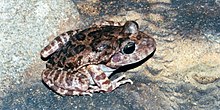
The northern sheep frog is native to Central America, Mexico, and extreme south Texas, United States. It occurs in the lowlands from Sonora, Mexico, to northern Costa Rica on the Pacific coast, and south Texas to Honduras on the Gulf of Mexico and Caribbean coasts. The sheep frog inhabits semiarid thornscrub, savannas, pasturelands, and open woodlands, as well as more humid, moist forest in the canyons, basins, foothills, and lower elevations of mountains slopes. It is a fossorial, burrowing frog that is seldom seen on the surface except at night after heavy rains when they emerge to breed. The sheep frog gets its name from its distinctive call that resembles a sheep's bleat. It is a diet specialist primarily feeding on termites and ants.
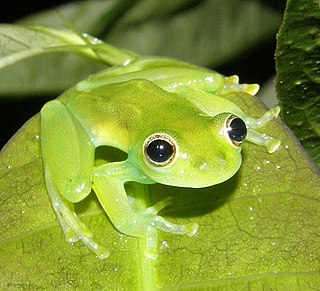
Teratohyla spinosa is a species of frog in the family Centrolenidae. It is found in the Pacific lowlands of northern and central Ecuador and western Colombia, northward on the Pacific slopes Panama and Costa Rica, as well as on the Caribbean slopes of Costa Rica, Nicaragua, and Honduras.

Leptopelis aubryi, also known as the Aubry's tree frog and Gaboon forest treefrog, is a species of frog in the family Arthroleptidae. It is found in southeastern Nigeria, Cameroon, Central African Republic, Equatorial Guinea, Gabon, Republic of the Congo, western and northern Democratic Republic of the Congo, and Angola.

Craugastor is a large genus of frogs in the family Craugastoridae with 126 species. Its scientific names means brittle-belly, from the Ancient Greek krauros and gastēr.
Craugastor andi is a species of rain frog in the family Craugastoridae which has not been seen since 1990. It is found in the Caribbean drainage of Costa Rica in the mountains and hills of the Cordillera Central and the far northeastern Cordillera de Talamanca, and in extreme northwestern Panama. Frank and Ramus (1995) give it the vernacular name Atlantic robber frog. It is known locally in Spanish by the generic names, used for many species, of rana de hojarasca, ranita or sapito.
Craugastor chrysozetetes is a possibly extinct species of frog in the family Craugastoridae. It is endemic to Honduras where it is only known from near its type locality on the Cerro Búfalo, Cordillera de Nombre de Dios, at the edge of the Pico Bonito National Park. Common name McCranie's robber frog has been coined for this species. However, James McCranie himself has argued that this name "should be rejected in favor of a name associated with the type locality instead of a name tied to one of the three authors who named this species".
Craugastor guerreroensis, also known as the Guerreran robber frog, is a species of frog in the family Craugastoridae. It is endemic to Mexico and only known from its type locality near Agua del Obispo, in the municipality of Chilpancingo de los Bravo, Guerrero.
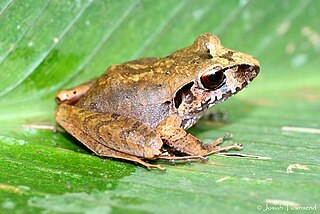
Craugastor laticeps is a species of frog in the family Craugastoridae. It is found in Belize, Guatemala, Honduras, and southern Mexico.
Craugastor monnichorum is a species of frog in the family Craugastoridae. It is endemic to the mountains of western Panama in the Chiriquí Province; the type locality is on the slope of Volcán Barú. The specific name monnichorum honors the Monniche family, owners of the property where the type series was collected. However, the common name coined for this species, Dunn's robber frog, refers instead to the scientist who described the species, Emmett Reid Dunn.
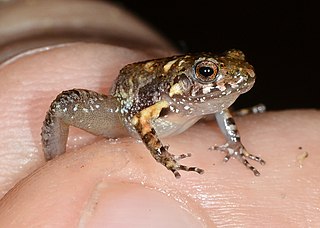
Craugastor pygmaeus, also known as the pigmy free-fingered frog or the pigmy robber frog, is a species of frog in the family Craugastoridae. It is found in western Guatemala and southern Mexico from southern Sinaloa to Chiapas.

Craugastor raniformis is a species of frog in the family Craugastoridae. It is found in Colombia and Panama. It is a reasonably common species found in humid lowland and montane forests up to 1,500 m (4,900 ft) asl. It is also common in wet pastureland. Furthermore, it is one of the dominant frogs in abandoned mixed farming areas in the coastal Pacific rainforests in Colombia. This adaptable species is not considered threatened.
Craugastor silvicola, also known as the forest robber frog, is a species of frog in the family Craugastoridae. It is endemic to Mexico and only known from its type locality near Zanatepec, Oaxaca, on the Isthmus of Tehuantepec.

Craugastor tarahumaraensis is a species of frog in the family Craugastoridae. It is endemic to Mexico and known from the Sierra Madre Occidental between the eastern Sonora and western Chihuahua in the north and Jalisco in the south. Its common name is Tarahumara barking frog. The type locality is Mojárachic, in the Tarahumara Mountains, Chihuahua.
Craugastor taylori is a species of frog in the family Craugastoridae. It is endemic to Mexico and only known from its type locality near Rayón Mescalapa, Chiapas, in Southeast Mexico. Its common name is Taylor's robber frog. It is named in honour of Edward Harrison Taylor.
Craugastor uno is a species of frog in the family Craugastoridae. It is endemic to Mexico and known from the Sierra Madre del Sur in Guerrero and southern Oaxaca. Common names Savage's robber frog and strange robber frog have been coined for it. The specific name uno refers to uniqueness of this species among its relatives.
Craugastor vulcani is a species of frog in the family Craugastoridae. It is endemic to the Sierra de los Tuxtlas range in southern Veracruz state, Mexico. Its name refers to its type locality on the San Martin Tuxtla volcano. Common name Volcan San Martin rainfrog has been proposed for it.
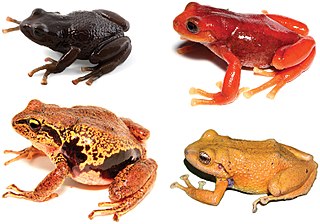
Craugastoridae, commonly known as fleshbelly frogs, is a family of New World direct-developing frogs. As delineated here, following the Amphibian Species of the World, it contains 123 species. They are found from the southern United States southwards to Central and South America.
